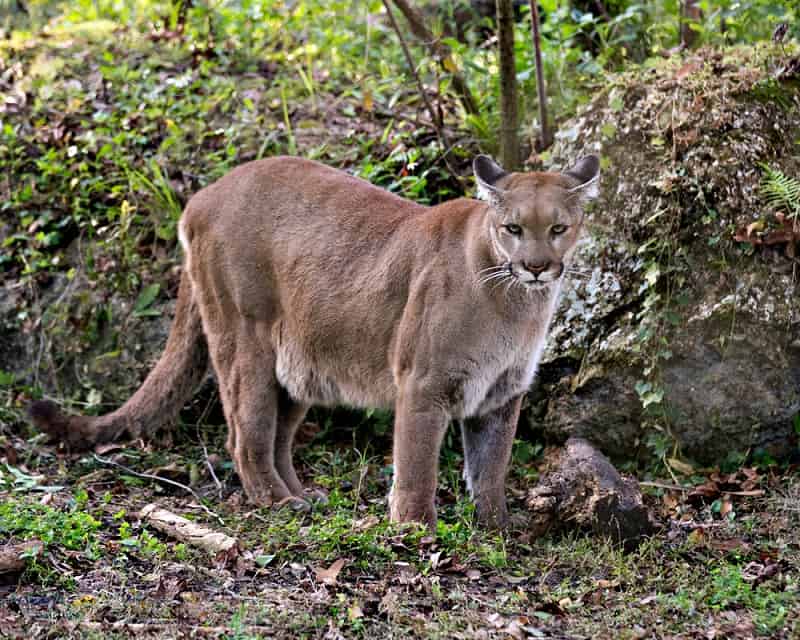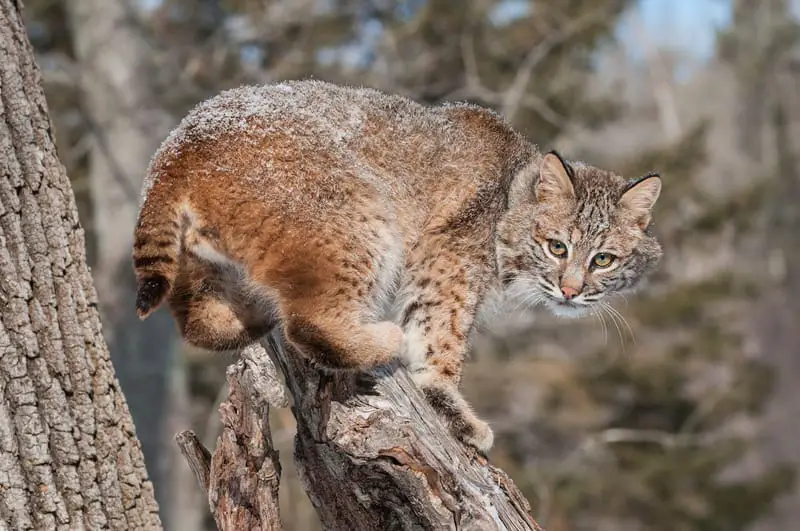Are there wild cats in Kansas, along with all the other wildlife in the state? The answer is yes. According to the Kansas Department of Wildlife & Parks, the bobcat (Lynx rufus) is the state’s only native wild cat.
However, mountain lions are also native to the sunflower state even though, like black bears, they have been extirpated from the state. In recent years, there have been quite a few confirmed sightings of mountain lions in Kansas. We’ll talk about these, and we’ll also talk about how mountain lion sightings do not necessarily equate to a breeding population of mountain lions.
We’ll do that towards the bottom of the article. First off, though, let’s talk about the Bobcat population in the state of Kansas.
Bobcats in Kansas (Lynx rufus)
The Bobcat, which is also known as the red lynx, is a North American wild cat. Biologists believe that both the bobcat and the Canada lynx are descendants of the Eurasian lynx whose ancestors crossed into North America via the Bearing Sea land bridge.
Bobcats reside only in North America. Their range begins in Canada. Central British Columbia is the furthest north that bobcats live. Their range extends south through the United States and down into central Mexico. They are the most common wildcats in North America.
Bobcats are most numerous in southeast Kansas. However, they range throughout the state. They favor broken habitat types that might include riparian woodland, dense forests, ravines, rocky ledges and/or outcroppings, and field borders.
The mottled pattern of their fur gives them excellent camouflage to live undetected in these environments.
Bobcats do not hibernate. They are active throughout the year. However, they’re rarely seen since they’re predominantly nocturnal or crepuscular animals. See
Bobcats are solitary animals with the exceptions of during mating season or when a female is raising young. They are territorial and live in home ranges that they patrol and scent mark with urine and feces.
The size of their home ranges varies with the geography and the availability of prey. However, in Kansas, female bobcat home ranges average 2 to 4 square miles while male bobcat home ranges average twice that size.
It’s also important to note that male and female bobcat home ranges sometimes overlap.

What do bobcats look like?
A bobcat is much smaller than a mountain lion and slightly smaller than a Canada lynx. An average bobcat is about twice the size of a domestic cat.
A bobcat is 2 to 3 feet long and weighs about 15 to 35 pounds. A female bobcat is quite a bit smaller than a male.
These animals have a “bobbed,” short tail with black bands on its upper surface. Their tail also has a black tip on its upper surface but not the back. Their fur is usually gray to brown, with mottled black spots that range from black to dark brown on their bodies. They also have black stripes on their inner forelegs and tail.
From a side view, you will notice that a bobcat is slightly higher at the rump than at the shoulders. Bobcats and lynx have long hind legs in proportion to their forelegs.
Bobcats have black-tufted ears. In other words, they have tufts of hair that poke up above their ears that are black at the tips. They do have shorter ear tufts than their close relative, the Canada lynx.
The backs of their ears, below the black tips, are black. In the center of the black of each ear, they have a single white spot. This gives the impression of a false eye on the back of each ear.
They also have a whiskered face that seems broader due to their long ruffled facial hair and whiskers. Their eyes are yellow with round black pupils.
Bobcats aren’t adapted for deep snow.
Compared to Canada lynx, which thrive in deep snow country, bobcats struggle more in the snow due to the fact that they cannot walk on top of it like lynx can. A lynx’s large paws function like snowshoes keeping it on the snow’s surface. On the other hand, compared to lynx, bobcats have small feet that tend to sink into the snow. If the snow is too deep and powdery, it reduces their mobility along with their ability to catch prey.
This is why the bobcat range dies out in southern Canada; from there on north, Canada lynx are more prevalent and bobcats, less so.
Bobcats are also unable to live at higher elevations as lynx do in the winter. In the winter, lynx are able to stay in the high country to hunt their preferred prey, snowshoe hares.
What do bobcats eat?
Despite their comparatively small size, bobcats are aggressive, tough predators. At times, particularly during the winter, they prey on large mammals that are much larger than they are, such as deer. However, in Kansas, their regular diets mainly consist of smaller animals such as cottontail rabbits, jackrabbits, cotton rats, wood rats, beavers, muskrats, and porcupines, birds such as wild turkeys, lesser prairie chickens, and various songbirds, reptiles, insects, and carrion. When they take up residence close to a residential area, their menu might occasionally also include small agricultural animals, domestic cats, and small dogs.
Interestingly, they even prey on venomous snakes even though they are not immune to the venom. They accomplish this by using their quickness to pin the snake’s head down with a paw, after which they dispatch the snake with a quick bite to its spine behind the head.
The venomous snakes in Kansas are the Western Cottonmouth, the Eastern copperhead, the Western Diamondback Rattlesnake, the Timber Rattlesnake, the Prairie Rattlesnake, and the Western Massasauga Rattlesnake. See
What eats bobcats?
In Kansas, coyotes, domestic dogs, great horned owls, and foxes may occasionally kill young bobcats. Other than that, these felines have no real predators.
Reproduction and lifecycle for bobcats in Kansas
The following quote was taken from the Kansas Mammal Atlas See
“Bobcats are polygamous, and females are seasonally polyestrous. Females that fail to become pregnant in early spring may come into heat again later in the spring or summer. Most copulations occur from January until July or August, but breeding may take place in any month. Females sometimes breed twice a year, and litters are born after an average gestation period of 63 days. Litter size in Kansas ranges from 1 to 6 (usually 2). The eyes are closed at birth, and they remain so until kittens are from 3 to 11 days old. Only the female is involved in care of young. Nursing lasts two months, and kittens are weaned at three months. The female begins taking the kittens with her when hunting at about three months. At six months, young Bobcats begin hunting alone but remain near the natal den. Dispersal occurs before the mother bears her next litter.”
Female bobcats reach sexual maturity at 1 year of age, while males reach sexual maturity at age 2.
The average life span of a wild bobcat is 7 to 10 years. See

Mountain lions in Kansas (Puma concolor)
Due to the fact that they live over a wide geographical area, mountain lions have a long list of regional names. In recent years, their scientific name was even changed from Felis concolor to Puma concolor. Some common names that mountain lions go by are cougar, panther painter, Andean Mountain lion, and puma.
Where are mountain lions typically found?
Mountain lions live on all three of the American continents. Their range begins in Canada’s Yukon territory and extends south through parts of North America, Central America, and South America to the southern tip of Argentina.
In Canada, the biggest populations of them are in British Columbia and Alberta. On the other hand, in the United States, they mainly live in the western united states and Florida in the southeast. In Florida, the cougar is called the Florida panther.
According to Kansas wildlife research biologist Matt Peek, there were 29 confirmed mountain lion sightings in Kansas between 2007 and 2020. Before 2007, the last cougar sighting in the state was in 1904. See
Biologists believe most of the lions sighted in Kansas have been young males that originated from expanding populations in nearby states. Young male cougars sometimes travel 100s of miles looking to establish their own home range in new territory in the vicinity of other cougars. A famous example of this occurred in 2011 when a young male cougar traveled over 1500 miles from South Dakota to be struck by a vehicle in Connecticut. See
Colorado mountain lions live within 75 miles of the border with southwest Kansas. There have also been multiple mountain lion sightings in the Oklahoma panhandle.
Finally, as noted above, mountain lions have also been dispersing from the Black Hills of South Dakota into several midwestern and eastern states. So far, these animals seem to be passing through Kansas, rather than staying and establishing home ranges. The KDWP has seen no evidence of resident cougars or a breeding population of them within the state.

What do mountain lions look like?
To visualize what a mountain lion looks like, picture a giant house cat with short, light brown fur. Mountain lions are much larger than domestic cats, though. Average house cats weigh in at around 10 pounds, while male mountain lions can weigh over 200 pounds.
These large cats have muscular slender bodies, rounded small heads, and upright ears that are oval at the tip. Another characteristic that mountain lions have is their muscular long tails, which account for almost one-third of the entire length of the animal. They use their long tail for a counterbalance, moving it from side to side as they navigate through uneven terrain.
Mountain lions have a tan coat of short, coarse hair over most of their body. The area around their nose, the tip of their tail, and the tips of their ears are black. Their belly, the area above their upper lip, below their lower lip, and their chin are all white. They also have a sprinkling of dark hair on their backs. There are some coat color variances between different geographic locations.
Mountain lions are the second largest cat in the western hemisphere, smaller only than the Jaguar, (Panthera onca). However, worldwide, the African Lion, ((Panthera leo) and the Tiger, (Panthera tigris) are also larger.
Male and female mountain lions are phenotypically identical in every respect except for size. Males are 30 to 40% bigger than females. Though sizes vary considerably throughout the cat’s geographic range, an adult male typically weighs between 110 and 180 pounds, 50 to (82 kgs). A rare few of them grow bigger than 200 pounds (91kgs). Female mountain lions or queens average between 80 and 130 pounds (36 to 59 kgs). Adult males or toms will reach a length of 6 to 8 feet (1.8 to 2.4 M) from their snout to the tip of their tail. On the other hand, adult females are 5 to 7 feet long (1.5 to 2.1 M).
Large cats but not big cats
A fun fact is that despite their large size, they are not taxonomically classified as big cats because they cannot roar. Snow leopards, for example, are smaller than mountain lions, but since they can roar and cannot purr, they are classified as big cats, while mountain lions are not. Another interesting thing that I can mention here is that mountain lions purr.
Since they purr and cannot roar, mountain lions are in the Felis genus, while big cats that cannot purr and can roar are in the Panthera genus.
As of the year 2017, mountain lions are taxonomically divided into 2 sub-species. The first is (Puma concolor couguar) or northern cougar. Northern cougars range through North America, Central America, and possibly northwestern South America. The second sub-species is (Puma concolor concolor) or southern cougar. These cats range only in South America.
What do mountain lions eat?
Mountain lions account for around 18 pounds of biomass and consume around 10 pounds of meat per day. To do this, an adult mountain lion has to kill a deer or a deer’s equivalent in meat around once a week. A mountain lion’s preferred prey is deer. However, they also prey on other animals.
In Kansas, mountain lions would prey on mule deer, white-tailed deer, elk, pronghorns, feral horses, coyotes, raccoons, rabbits, wild turkeys, miscellaneous birds, pack rats, various small rodents, prairie dogs, porcupines, skunks, snakes, pets, feral cats, livestock, and any other native wild animals they can catch.
Mountain lion behavior
Mountain lions are solitary animals. It’s a Rarity to see 2 or more together unless during mating or in the case of a female raising young. They have expansive home ranges.
They have expansive home ranges. In fact, an adult male cougar’s home range is normally more than 100 square miles and up to 250 square miles. They will sometimes mark their territory by leaving claw marks on trees. They also scratch up piles of leaves and or pine needles that they urinate on as a scent marker. Male mountain lions fight to the death sometimes to defend their territory.
Do mountain lions ever harm humans?
I’ve taken much of the following section from another one of my blog posts entitled “Are Mountain Lions Dangerous?” Found here.
Fatal mountain lion attacks on humans are extremely rare. In fact, there are only 20 records of fatal mountain lion attacks on humans in all of North America in the last 100 years. Don’t let that fact lull you into a complete sense of false security, though. There have been many more mountain lion attacks over the years that didn’t result in a fatality. Mountain lions are, in fact, dangerous.
A mountain lion is a formidably tough wild predatory animal. They can run 40 to 50 miles per hour for short bursts. Additionally, they can leap 18 feet vertically and 40 feet horizontally to catch their prey. These ninja-like predators typically stalk their prey from behind and then leap on an animal’s back. They then crush their cervical spine or larynx with their powerful jaws. They have a bite force of 750 pounds per square inch.
Here are a couple of recent examples of non-fatal mountain lion attacks on humans. See See
Some factors that cause mountain lions to attack humans
The majority of the time, mountain lions use their ghost-like skills to avoid human contact. On rare occasions, though, they attack humans. Below are a few of the reasons why.
- If the cougar has an injury or some sort of impairment that prevents it from killing its normal prey, it’ll be more likely to look at a person as potential prey.
- Male mountain lions engage in fights for territory. Some of their battles are to the death. A percentage of cougar attacks on humans are perpetrated by hungry young males that have been kicked out of territories with a more abundant food supply.
- Scientific data suggests that mountain lions that were orphaned at a young age are more likely to attack humans. This is possibly because they missed the part of their training where their mothers taught them that humans are to be feared.
If a mountain lion is stalking you
- Never run away. According to a Multidisciplinary Journal of the Interactions of People and Animals, those who try to run away when they encounter a mountain lion put themselves at greater risk of sustaining serious injuries and even death. Running away triggers a lion’s instinct to chase.
- Stay as calm as you can. Panic is your enemy. In a survival situation such as this, a cool head will put you at a better advantage.
- Speak firmly in a loud voice but avoid a high-pitched tone or screaming
- You need to hold your ground when the cat is coming towards you and slowly back away when it pauses its approach
- Stand upright. Avoid bending over or crouching down as much as possible, as this puts you in the vulnerable position of appearing like a small, four-legged animal that can easily become prey.
- Open your jacket if you’re wearing one to appear larger. and wave your arms slowly to give yourself the appearance of having as much size as possible as you back away slowly. You can also throw stones, tree branches, or other objects at the lion.
- If you’re walking with a child, pick them up and hold them in your arms.
If you’ve done all the above, there’s still that small chance that you’ll still be attacked by the mountain lion. You need to be mentally prepared for this. At this point, do not panic and freeze up. In order to survive, you’ll need to fight back with as much aggression as you can muster.
Historical accounts show that people have successfully fought mountain lions off with their bare hands, sticks, rocks, garden tools, or any other weapon within reach. You already have a ready-made weapon if you’re using a walking stick. Target sensitive areas such as the eyes and nose, and hit as hard as you can! You should also try to remain standing if possible. You’ll lose some of your advantage on the ground. If you get knocked down, try as hard as possible to protect your neck and head as you continue to fight back
Recent Posts
The only venomous snakes in Washington State are Northern Pacific Rattlesnakes. The Northern Pacific Rattlesnake (Crotalus oreganus oreganus) is a sub-species of the Western Rattlesnake. Anyone...
Skunks are not classified as true hibernators. But they go into a state of torpor when the weather gets cold. Skunks are light sleep hibernators, along with opossums, bears, and raccoons. ...

